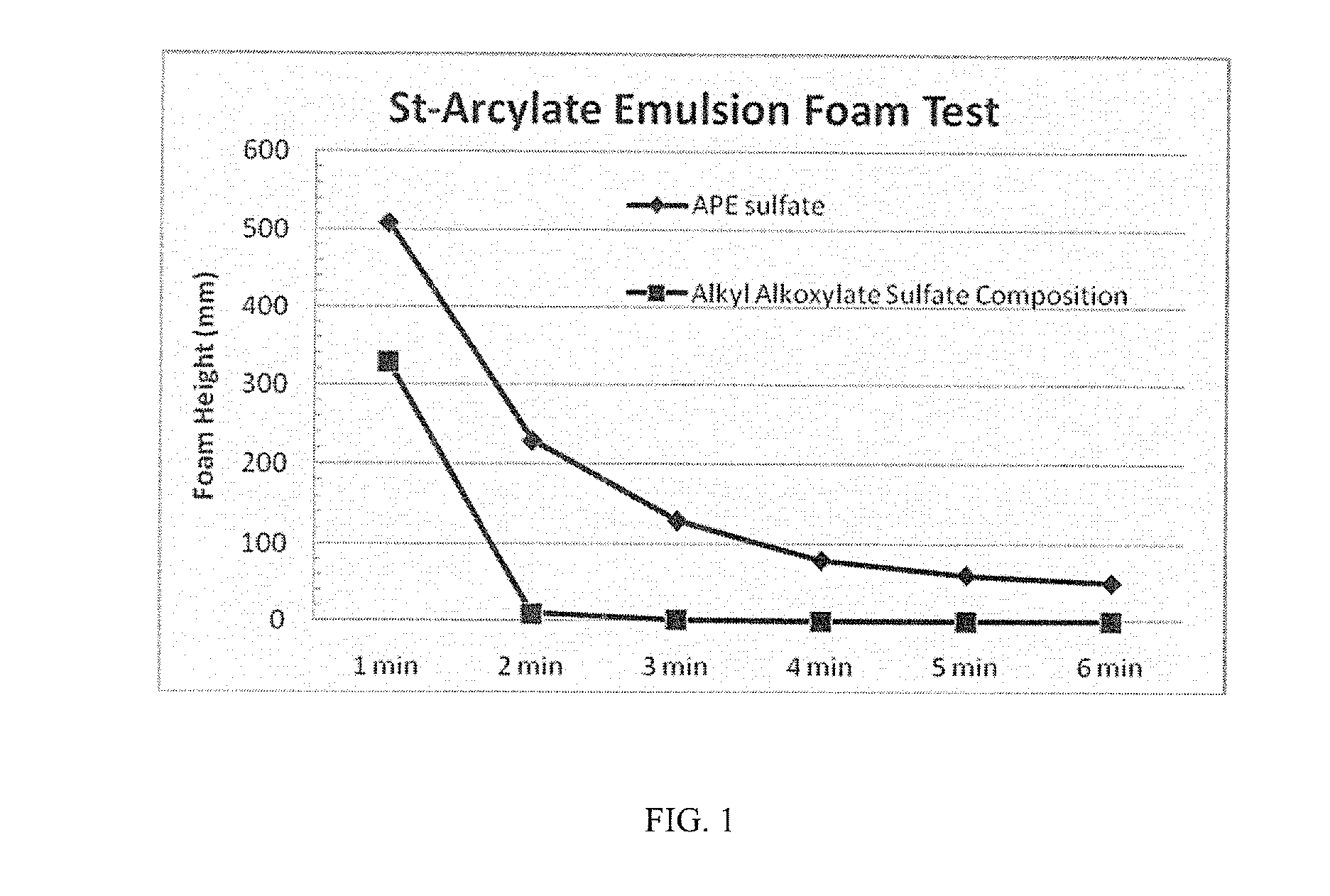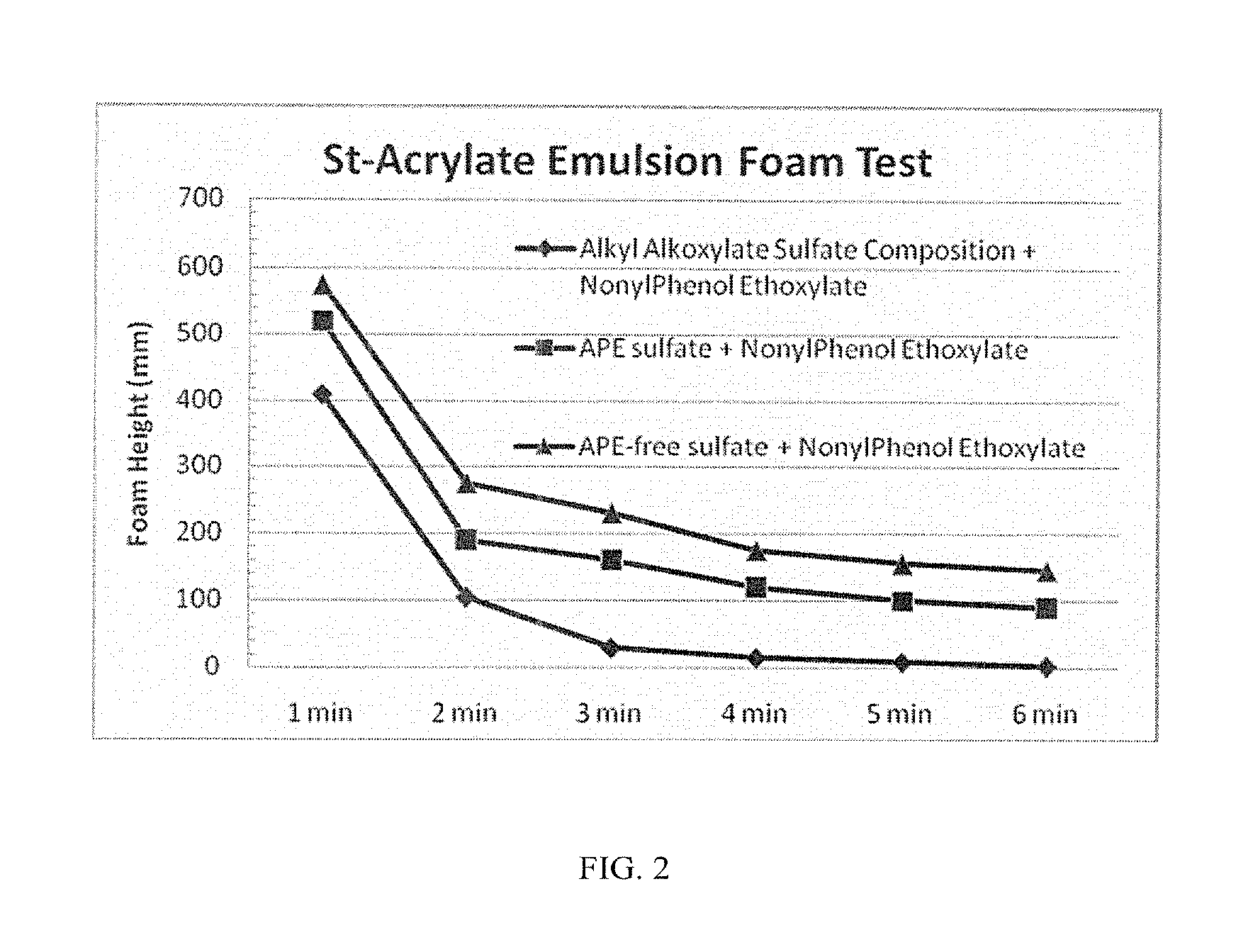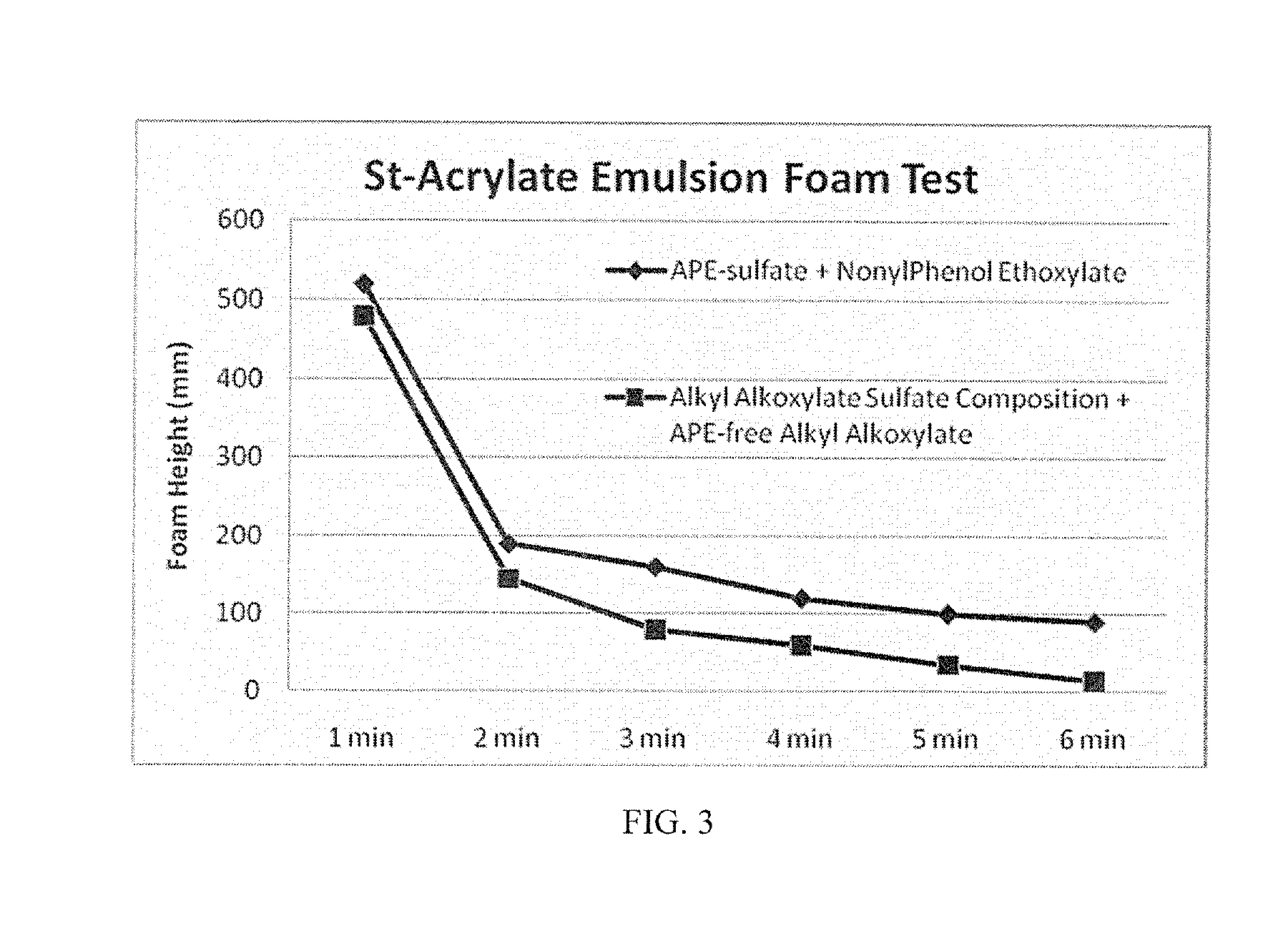Anionic surfactant compositions and use thereof
a technology of surfactant composition and composition, which is applied in the field of surfactant composition, can solve the problems of poor public perception of environmental compatibility of ape surfactants, decline of ape type surfactants, and poor use of ape type surfactants, and achieves good surface tension reduction, low foam, and quick foam collapse
- Summary
- Abstract
- Description
- Claims
- Application Information
AI Technical Summary
Benefits of technology
Problems solved by technology
Method used
Image
Examples
example 1
[0046]Several alkyl alkoxylate sulfate compositions were prepared, including both sodium salt and ammonium salt. Lab-scale samples were prepared based on Chemithon sulfation process. The SO3 was diluted with air to the ratio at 3.5% vol., then, reacted with pre-heated nonionic alkyl alkoxylate surfactants (at 40° C.) in a falling thin film reactor (length 2 m). Molar ratio of SO3 to nonionic alkyl alkoxylate was maintained in the range of 0.98-1.0 by adjustment of the flowrate of nonionic alkyl alkoxylate (3-5 kg / h) to the reactor. Cooling water system was applied in the thin film reactor and the temperature in the ether sulfuric acid tank was measured around 55° C., followed with a prompt neutralization by NaOH or ammonia water with stirring.
[0047]Formation of the desired compound was confirmed by NMR. The 13C NMR spectrum showed the disappearance of —CH2OH carbon at the chemical shift at δ=62.0 ppm and the presence of —CH2OSO3− carbon at δ=68.0 ppm, which indicated the high conver...
example 2
[0048]Various properties of inventive and comparative compositions are shown in Table 2.
TABLE 2Alkyl alkoxylateAlkylsulfate + Nonionicalkoxylatealkyl alkoxylate 1sulfate(90:10 by wt)APE SulfateAPE-free sulfate(inventive)(inventive)(comparative)(comparative)Active content (%)505058-6030-32Appearance (20° C.)clear, paleclear, paleclear, paleclear, pale(visual measurement)yellowyellowyellowyellowSurface Tension at35323442CMC (mN / m, 20° C.)1CMC (ppm)30002000300125(Based on SurfaceTension measurement)Foam Height (Ross108 / 2493 / 17106 / 102113 / 112Miles, 0 / 5 min at0.2%)2Draves wetting (s)35.3 + / − 0.53.0 + / − 0.45.9 + / − 0.4263.0 + / − 32.9Ca2+ stability10-15% wt.10-15% wt.≈15% wt.(CaCl2, 1%Surfactant)4Anti-alkaline (NaOH, 5-10% wt. 5-10% wt.10-15% wt.1% surfactant)5Viscosity (cP, at 20° C.245202120.563.5& 60 rpm, #62 probe)1Measured according to standard GB / T-5549-2010;2by GB / T 7462-94 standard;3by GB / T 11983-2008 standard;4by GB / T 7381-2010;5by GB / T 5556-2003 standard.
[0049]As is ...
example 3
Basic Formula of Styrene-Butyl Acrylate Emulsion:
[0050]Monomers include: butyl acrylate, styrene, acrylamide and acrylic acid;
[0051]Initiator is ammonium persulfate;
[0052]Glass transition temperature (Tg): 23° C.;
[0053]Anionic surfactants: 0.51 phm (per hundred monomer); non-ionic surfactants: 0.54 phm.
Basic Formulation of Pure Acrylate Emulsion:
[0054]Monomers include: acrylic acid, butyl acrylate, methacrylic acid;
[0055]Glass transition temperature (Tg): 10° C.;
[0056]Anionic surfactants: 1.0 phm.
Basic Polymerization Procedure of Styrene-Butyl Acrylate Emulsion:
[0057]Pre-emulsify the alkyl alkoxylate sulfate composition with sodium bicarbonate, water and above mentioned monomers. Add the second part of surfactant composition and water into the reactor; start heating to the temperature in the range of 80-90° C.; then, add the first part of ammonium persulfate. Start dropwise addition of pre-emulsion with the second part of ammonium persulfate during 3 h. After ...
PUM
| Property | Measurement | Unit |
|---|---|---|
| total weight | aaaaa | aaaaa |
| chemical structure | aaaaa | aaaaa |
| environmental compatibility | aaaaa | aaaaa |
Abstract
Description
Claims
Application Information
 Login to View More
Login to View More - R&D
- Intellectual Property
- Life Sciences
- Materials
- Tech Scout
- Unparalleled Data Quality
- Higher Quality Content
- 60% Fewer Hallucinations
Browse by: Latest US Patents, China's latest patents, Technical Efficacy Thesaurus, Application Domain, Technology Topic, Popular Technical Reports.
© 2025 PatSnap. All rights reserved.Legal|Privacy policy|Modern Slavery Act Transparency Statement|Sitemap|About US| Contact US: help@patsnap.com



